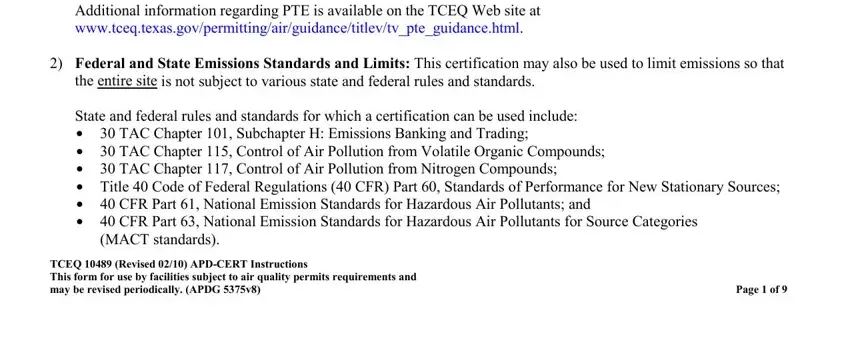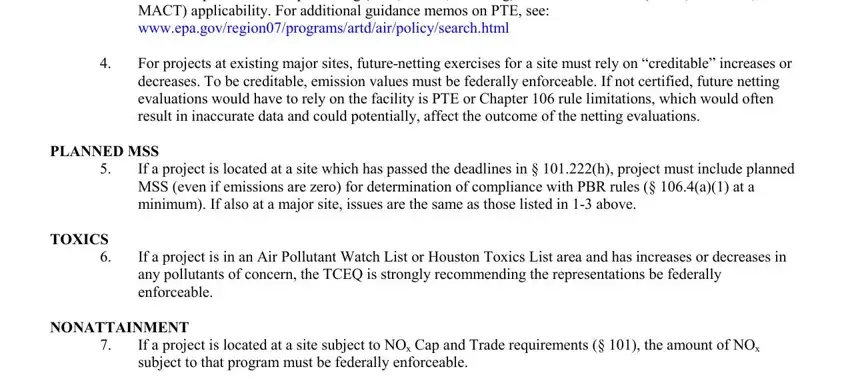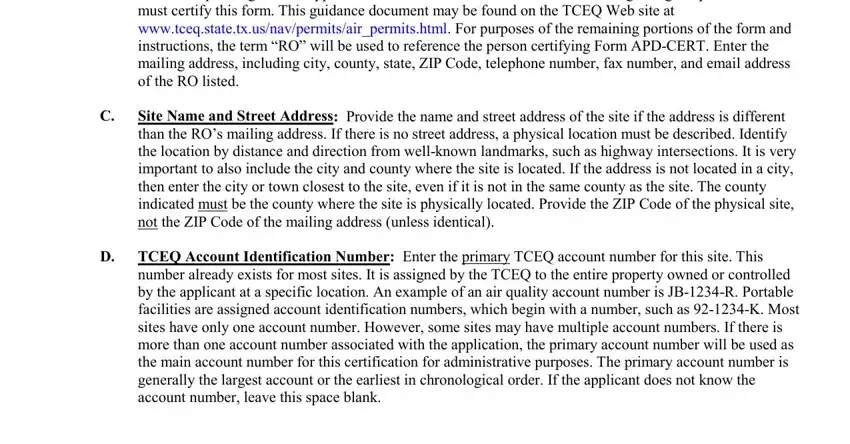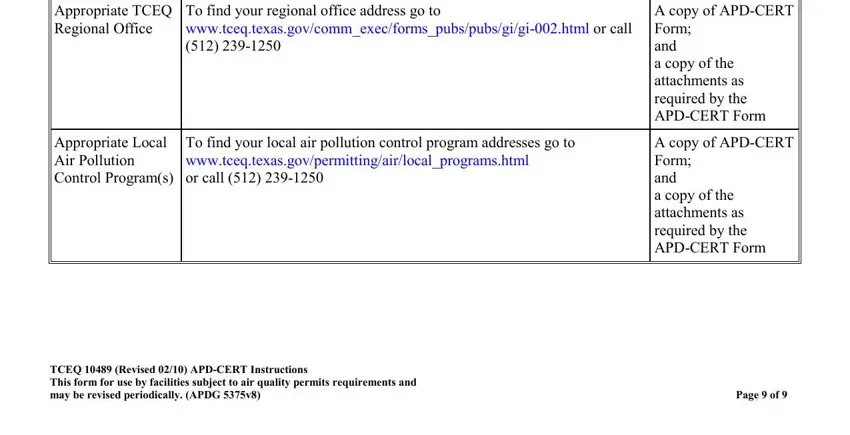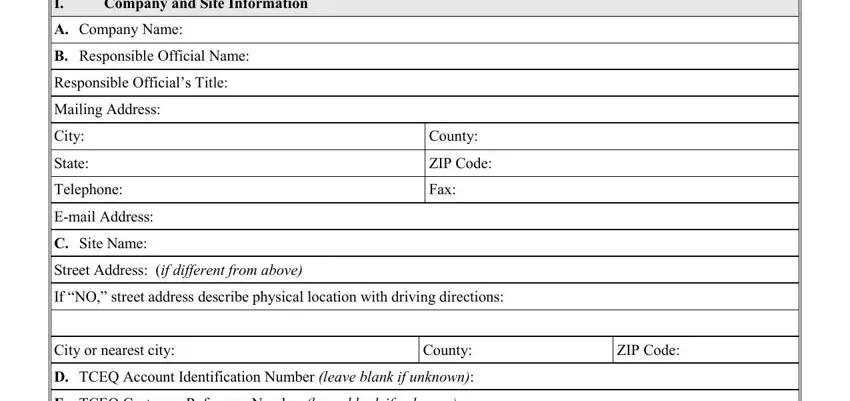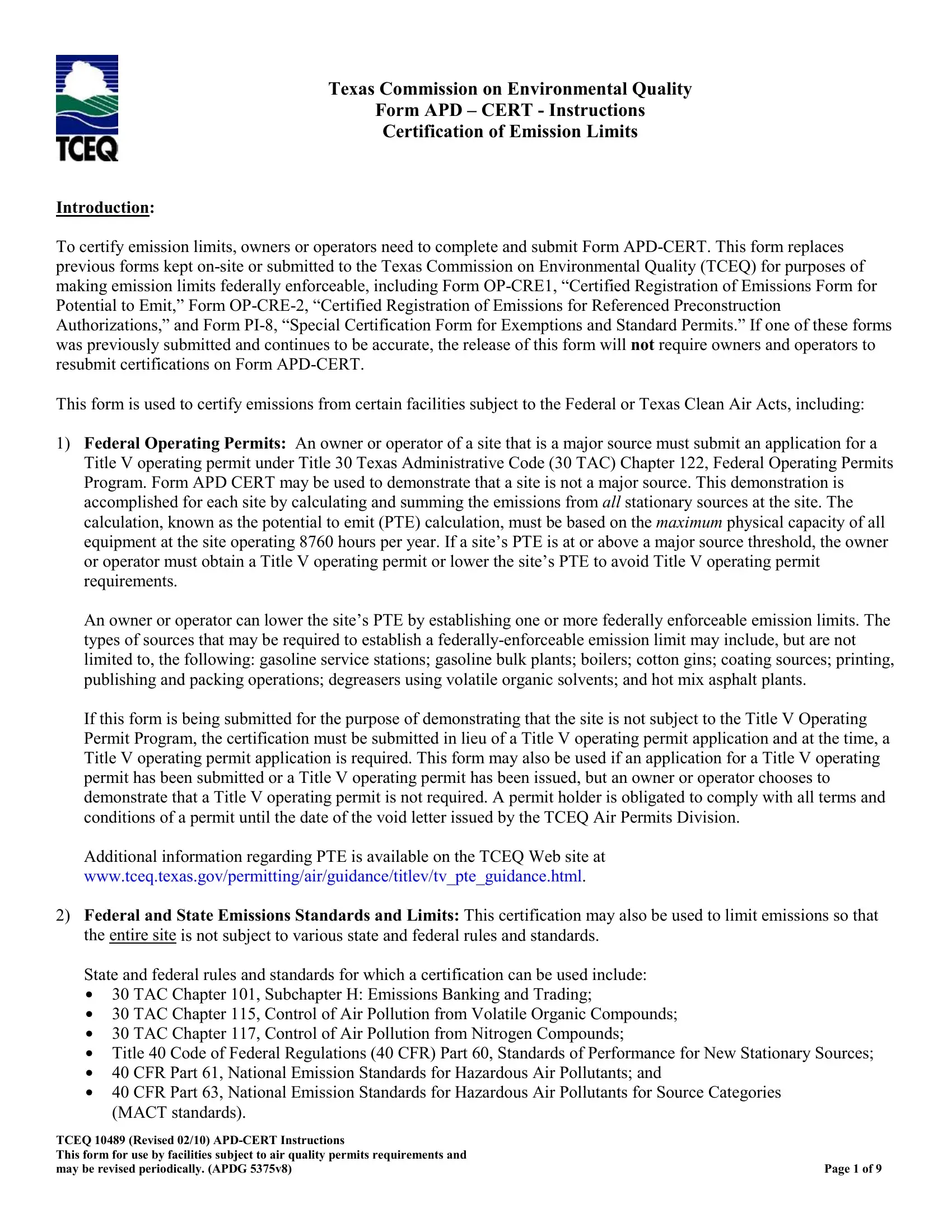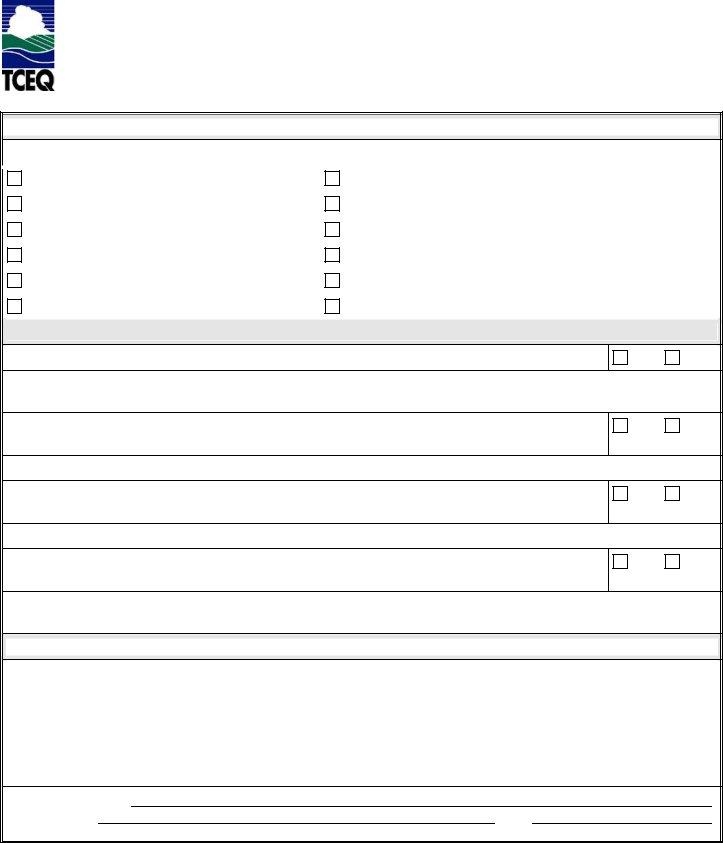Texas Commission on Environmental Quality
Form APD – CERT - Instructions
Certification of Emission Limits
Introduction:
To certify emission limits, owners or operators need to complete and submit Form APD-CERT. This form replaces previous forms kept on-site or submitted to the Texas Commission on Environmental Quality (TCEQ) for purposes of making emission limits federally enforceable, including Form OP-CRE1, “Certified Registration of Emissions Form for Potential to Emit,” Form OP-CRE-2, “Certified Registration of Emissions for Referenced Preconstruction Authorizations,” and Form PI-8, “Special Certification Form for Exemptions and Standard Permits.” If one of these forms was previously submitted and continues to be accurate, the release of this form will not require owners and operators to resubmit certifications on Form APD-CERT.
This form is used to certify emissions from certain facilities subject to the Federal or Texas Clean Air Acts, including:
1)Federal Operating Permits: An owner or operator of a site that is a major source must submit an application for a Title V operating permit under Title 30 Texas Administrative Code (30 TAC) Chapter 122, Federal Operating Permits Program. Form APD CERT may be used to demonstrate that a site is not a major source. This demonstration is accomplished for each site by calculating and summing the emissions from all stationary sources at the site. The calculation, known as the potential to emit (PTE) calculation, must be based on the maximum physical capacity of all equipment at the site operating 8760 hours per year. If a site’s PTE is at or above a major source threshold, the owner or operator must obtain a Title V operating permit or lower the site’s PTE to avoid Title V operating permit requirements.
An owner or operator can lower the site’s PTE by establishing one or more federally enforceable emission limits. The types of sources that may be required to establish a federally-enforceable emission limit may include, but are not limited to, the following: gasoline service stations; gasoline bulk plants; boilers; cotton gins; coating sources; printing, publishing and packing operations; degreasers using volatile organic solvents; and hot mix asphalt plants.
If this form is being submitted for the purpose of demonstrating that the site is not subject to the Title V Operating Permit Program, the certification must be submitted in lieu of a Title V operating permit application and at the time, a Title V operating permit application is required. This form may also be used if an application for a Title V operating permit has been submitted or a Title V operating permit has been issued, but an owner or operator chooses to demonstrate that a Title V operating permit is not required. A permit holder is obligated to comply with all terms and conditions of a permit until the date of the void letter issued by the TCEQ Air Permits Division.
Additional information regarding PTE is available on the TCEQ Web site at www.tceq.texas.gov/permitting/air/guidance/titlev/tv_pte_guidance.html.
2)Federal and State Emissions Standards and Limits: This certification may also be used to limit emissions so that the entire site is not subject to various state and federal rules and standards.
State and federal rules and standards for which a certification can be used include: $ 30 TAC Chapter 101, Subchapter H: Emissions Banking and Trading;
$ 30 TAC Chapter 115, Control of Air Pollution from Volatile Organic Compounds; $ 30 TAC Chapter 117, Control of Air Pollution from Nitrogen Compounds;
$ Title 40 Code of Federal Regulations (40 CFR) Part 60, Standards of Performance for New Stationary Sources; $ 40 CFR Part 61, National Emission Standards for Hazardous Air Pollutants; and
$ 40 CFR Part 63, National Emission Standards for Hazardous Air Pollutants for Source Categories (MACT standards).
TCEQ 10489 (Revised 02/10) APD-CERT Instructions |
|
This form for use by facilities subject to air quality permits requirements and |
|
may be revised periodically. (APDG 5375v8) |
Page 1 of 9 |
Form APD-CERT Instructions
3)Establishing Federally-Enforceable Highly-Reactive Volatile Organic Compound (HRVOC) Limits: For sites located in
the Houston/Galveston/Brazoria nonattainment area exempt from the requirements of 30 TAC Chapter 101, Subchapter H, Division 6, Highly-Reactive Volatile Organic Compound Emissions Cap and Trade Program, under
30 TAC § 101.392(c), Exemptions, enforceable documentation of HRVOC emissions must be provided in accordance with 30 TAC § 101.401(e), Level of Activity Certification. Each site with a potential to emit more than ten tpy of HRVOC must establish enforceable limits on HRVOC emissions from vent gas streams, flares, and cooling tower heat exchangers subject to the control requirements of 30 TAC Chapter 115, Subchapter H, Highly Reactive Volatile Organic Compounds, at levels represented in the most recent applications to the executive director for authorization under 30 TAC Chapter 116, Control of Air Pollution by Permits for New Construction or Modification. As required by 30 TAC § 101.401(e), enforceable documentation of the maximum allowable emission rates for HRVOC emissions must be submitted in conjunction with Form ECT-3H, Highly-Reactive Volatile Organic Compound Emissions Cap and Trade Level of Activity Certification Form. Submitting Form APD-CERT with Form ECT-3H satisfies the requirement of 30 TAC § 101.401(e). The HRVOC information submitted on Form APD-CERT, for facility identification number (FIN), facility name, emission point number (EPN), and point name, should be identical to the information reported on the 2003 Emissions Inventory Questionnaire.
For sites located in the Houston/Galveston/Brazoria nonattainment area that are subject to the requirements of
30 TAC Chapter 101, Subchapter H, Division 6, Highly-Reactive Volatile Organic Compound Emissions Cap and Trade Program, enforceable documentation of HRVOC emissions also must be provided in accordance with 30 TAC § 101.401(e), Level of Activity Certification. Each site with a potential to emit more than ten tpy of HRVOC must establish enforceable limits on HRVOC emissions from vent gas streams, flares, and cooling tower heat exchangers subject to the control requirements of 30 TAC Chapter 115, Subchapter H, Highly Reactive Volatile Organic Compounds, that are imposed by the Maximum Allowable Emission Rate Table (MAERT) in permits issued under 30 TAC Chapter 116, Control of Air Pollution by Permits for New Construction or Modification. If an enforceable limit in a MAERT is expressed as total VOC, then report the total VOC authorization applicable to that emission point. In addition, for any emission point for which limits on HRVOC are expressed as total VOC, estimate in a separate, non-certified attachment the maximum hourly and annual emission rate for each HRVOC species emitted from the emission point. The estimates should be based on the best information available at the time the estimate is made. The total of the estimates of individual HRVOC emission rates may be greater than the total VOC authorization. The estimated HRVOC emissions do not constitute an enforceable emission limit. The information submitted on Form APD-CERT, or as a separate attachment, for facility identification number (FIN), facility name, emission point number (EPN), and point name should be identical to the information reported on the 2003 Emissions Inventory Questionnaire.
General Uses of Form APD-CERT:
Federally-enforceable emission limits to avoid Title V or other federal or state requirements may be established in a case- by-case new source review permit issued under 30 TAC Chapter 116. If the site is authorized by one permit by rule under 30 TAC Chapter 106, Permits by Rule, the federally-enforceable emission limits in 30 TAC § 106.4, Requirements for Permitting by Rule, or contained in a particular permit by rule may be sufficient to demonstrate that Title V or other requirements do not apply. Limits contained in maximum emission rates listed in a standard permit authorization letter issued by the TCEQ executive director are also federally enforceable. However, if emissions are not limited by one of these mechanisms, the owner or operator may establish a federally enforceable emission limit by submitting Form APD-CERT. Form APD-CERT may be submitted if the owner or operator chooses to impose a more stringent limit than established by 30 TAC § 106.4, a specific permit by rule, or a standard permit letter issued by the TCEQ executive director. Note: Form APD-CERT cannot be submitted for a case-by-case air permit issued under Chapter 116, unless the certification is solely submitted for the purpose of establishing federally enforceable limits for HRVOCs, as the owner or operator would be required to amend or alter the permit in order to revise its maximum emission rates. It should be noted that if this form is used to establish federally-enforceable HRVOC limits for a source that has been issued a case-by-case new source review permit, the HRVOC limits will eventually be required to be included into the NSR permit.
TCEQ 10489 (Revised 02/10) APD-CERT Instructions |
|
This form for use by facilities subject to air quality permits requirements and |
|
may be revised periodically. (APDG 5375v8) |
Page 2 of 9 |
Form APD-CERT Instructions
The certification must demonstrate that the entire site is not subject to Title V operating permit requirements or other state and federal rules, as specified above. It is important to note that emission rates listed on Form PI-7, “Registration for Permits by Rule” or Form PI-1S, “Registration for Air Standard Permit” are not enforceable emission rates. To provide a streamlined mechanism to establish these emission rates as federally enforceable, Form APD-CERT may be attached to a previously completed Form PI-7 or Form PI-1S. When changes at a site occur that change the representations previously submitted in a certified registration (Form APD-CERT, Form PI-7-CERT, Form PI-8, Form OP-CRE1, or Form OP-CRE2), a new Form APD-CERT must be submitted to demonstrate that the site is not subject to Title V operating permit requirements or other state and federal rules. Facilities that did not require registration for purposes of 30 TAC Chapter 106 will be required to submit Form APD-CERT to establish federally-enforceable emission limits if the site’s PTE is above a major source threshold and the owner or operator chooses to avoid Title V operating permit requirements or other state and federal rules. Form APD-CERT is not required if Form PI7-CERT is submitted.
Submitting this document commits the company to comply with the represented emission limits. Only a valid “responsible official” may sign this form. The Responsible Official (RO) is an individual (such as an owner of a site or the president of a corporation) who must certify the truth, accuracy and completeness of the information contained in the certification and who is subject to criminal prosecution for false information contained in the certification. RO authority may be delegated to a Duly Authorized Representative (DAR). If RO authority is being delegated, include a completed Form OP-DEL, “Delegation of the Responsible Official.” Form APD-CERT must bear the original signature of the RO or DAR; or, for sources subject to the acid rain program, the Designated Representative (DR), or Alternate Designated Representative (ADR). No electronic submittals, photocopies, faxes, or signature stamps can be accepted. Please refer to the TCEQ Air Permits Division guidance document, “Federal Operating Permit Application Guidance Document” for information regarding the RO, DAR, DR, and ADR.
NOTE: The following list is not inclusive of all reasons for which applicants may be asked to certify PBR registrations or claims.
FEDERAL NEW SOURCE REVIEW ISSUES
1.For projects at existing major sites, 106.4(a) (1) establishes limits for production and planned MSS for each facility (piece of equipment) at ≤ 250 tpy NOx and CO or 25 tpy VOC, PM, SO2, and any other contaminant. However, these limits are greater than the triggers/ thresholds for major sources or major modifications under NNSR or PSD, including but not limited to:
$ 5 tpy VOC or NOx netting triggers for NNSR areas $ 25 tpy, 50 tpy or 100 tpy NOx for NNSR areas
$ 40 tpy or 100 tpy NOx anywhere for PSD $ 100 tpy CO anywhere for PSD
$ 15 tpy PM10 anywhere for PSD $ 10 tpy PM2.5 anywhere for PSD
2.For projects at existing major sites, specific PBRs for plants or facilities may have no emission limits or allow emissions > triggers or thresholds for major sources or major modifications under NNSR or PSD. Examples include, but are not limited to: § 106.261 allow 10 tpy of NOx or VOC, but > 5 tpy VOC or NOx are the netting triggers for NNSR areas.
If projects at major sites are NOT certified, Reviewers must make the following major source or major project applicability analysis:
a.What federal review may be applicable? (NNSR or PSD)
b.Without consideration of any decreases in emissions, “total potential emission increases” must be less than netting or major source trigger levels. “Total emission increases” are based on the PBR rule limits, physical capacity/throughput of all facilities, continuous operation of 8760 hrs/yr, worst-case materials, and uncontrolled (unless the control is specified in the specific PBR). These increases must also include all planned MSS, whether registered or not, regardless of industry type.
TCEQ 10489 (Revised 02/10) APD-CERT Instructions |
|
This form for use by facilities subject to air quality permits requirements and |
|
may be revised periodically. (APDG 5375v8) |
Page 3 of 9 |
c.If PSD: CO ≤ 100 tpy, NOx ≤ 40 tpy, SO2 ≤ 40 tpy , VOC ≤ 40 tpy, PM10 ≤ 25 tpy, PM2.5 ≤ 10 tpy
(see PSD Guidance for additional air contaminant significance levels).
d.If NNSR: NOx ≤ 5 tpy, VOC ≤ 5 tpy
e.If netting is not required, continue thru this list for other possible reasons to certify the project. If netting is required based on the above, the PBR claim may be certified to show that netting is not required or netting must be submitted and certified.
3.If a project includes control technology, limited hours, throughput, and materials or other operational limitations, which are less than the Potential to Emit (PTE), EPA’s guidance is clear that these limitations must be federally enforceable. Establishing certified limits ensures EPA and Texas that these emissions can be relied upon for federal permitting (PSD, NNSR, and 112g) or federal standards (NSPS, NESHAP, MACT) applicability. For additional guidance memos on PTE, see: www.epa.gov/region07/programs/artd/air/policy/search.html
4.For projects at existing major sites, future-netting exercises for a site must rely on “creditable” increases or decreases. To be creditable, emission values must be federally enforceable. If not certified, future netting evaluations would have to rely on the facility is PTE or Chapter 106 rule limitations, which would often result in inaccurate data and could potentially, affect the outcome of the netting evaluations.
PLANNED MSS
5.If a project is located at a site which has passed the deadlines in § 101.222(h), project must include planned MSS (even if emissions are zero) for determination of compliance with PBR rules (§ 106.4(a)(1) at a minimum). If also at a major site, issues are the same as those listed in 1-3 above.
TOXICS
6.If a project is in an Air Pollutant Watch List or Houston Toxics List area and has increases or decreases in any pollutants of concern, the TCEQ is strongly recommending the representations be federally enforceable.
NONATTAINMENT
7.If a project is located at a site subject to NOx Cap and Trade requirements (§ 101), the amount of NOx subject to that program must be federally enforceable.
COMPLIANCE ASSURANCE
8.Certification establishes the basis for future compliance demonstrations and gives certainty to permit holders, regional investigators, permitting staff, and the general public. This certainly is especially important for Title V compliance certifications and deviation reports.
9.For projects, which resolve compliance, issues, in many cases Regional offices may request that PBRs be certified to ensure awareness of the requirements and expectations.
OTHER RULES AND REQUIREMENTS
10.For projects affecting facilities under Flexible Permits, § 116.720 requires that any PBR claim not exceed the permitted flexible caps. This statement should be certified to ensure it is enforceable.
11.Projects under § 106.261 and § 106.262 can add waste streams to existing permitted control devices. This is acceptable since the PBR requirements only limit “no changes to or additions of air pollution abatement equipment” since this scenario does not change the existing control. However, to ensure no backsliding of permitting effectiveness or destruction efficiency, the applicant should certify that the additional stream or
TCEQ 10489 (Revised 02/10) APD-CERT Instructions |
|
This form for use by facilities subject to air quality permits requirements and |
|
may be revised periodically. (APDG 5375v8) |
Page 4 of 9 |

Form APD-CERT Instructions
scenario would not affect the control’s DRE, thus ensuring continuing compliance with permitted representations of the control.
Records:
All certifications and records demonstrating compliance must be maintained on site or, for sites that normally operate unattended, at an office within Texas having day-to-day operational control of the site. Records must be kept for at least five years and must be made available upon request.
If you have any questions on how to complete this form, please contact the Air Permits Division at (512) 239-1250. If the site employs less than 100 employees, the Small Business and Environmental Assistance Division may be contacted at (512) 239 3100. Individuals are entitled to request and review their personal information that the agency gathers on its forms. They may also have any errors in their information corrected. To review such information, contact the Information Resources Division at (512) 239-3282.
Specific:
Page 1:
I.Company and Site Information
A.Company Name: Enter the name of the company for which the certification is being completed.
B.Responsible Official Name and Title: Enter the name and title of the RO pursuant to 30 TAC
§ 122.165(c), Certification by a Responsible Official. Please refer to the TCEQ guidance document, “Federal Operating Permit Application Guidance Document” for information regarding the person who must certify this form. This guidance document may be found on the TCEQ Web site at www.tceq.state.tx.us/nav/permits/air_permits.html. For purposes of the remaining portions of the form and instructions, the term “RO” will be used to reference the person certifying Form APD-CERT. Enter the mailing address, including city, county, state, ZIP Code, telephone number, fax number, and email address of the RO listed.
C.Site Name and Street Address: Provide the name and street address of the site if the address is different than the RO’s mailing address. If there is no street address, a physical location must be described. Identify the location by distance and direction from well-known landmarks, such as highway intersections. It is very important to also include the city and county where the site is located. If the address is not located in a city, then enter the city or town closest to the site, even if it is not in the same county as the site. The county indicated must be the county where the site is physically located. Provide the ZIP Code of the physical site, not the ZIP Code of the mailing address (unless identical).
D.TCEQ Account Identification Number: Enter the primary TCEQ account number for this site. This number already exists for most sites. It is assigned by the TCEQ to the entire property owned or controlled by the applicant at a specific location. An example of an air quality account number is JB-1234-R. Portable facilities are assigned account identification numbers, which begin with a number, such as 92-1234-K. Most sites have only one account number. However, some sites may have multiple account numbers. If there is more than one account number associated with the application, the primary account number will be used as the main account number for this certification for administrative purposes. The primary account number is generally the largest account or the earliest in chronological order. If the applicant does not know the account number, leave this space blank.
TCEQ 10489 (Revised 02/10) APD-CERT Instructions |
|
This form for use by facilities subject to air quality permits requirements and |
|
may be revised periodically. (APDG 5375v8) |
Page 5 of 9 |
Form APD-CERT Instructions
E.TCEQ Customer Reference Number and Regulated Entity Number: Enter the customer reference number and the regulated entity number. These numbers are assigned by the TCEQ as part of the Central Registry process. The customer reference number always begins with “CN” and the regulated entity number always begins with “RN.” If these numbers have not been issued to the applicant, leave this space blank.
F.Does the site have a Title V Permit? Check the box marked “YES” if all or part of the site has been or will be issued a Title V Operating Permit. Otherwise, check the box marked “NO.”
This form is not required for sites that have been issued a Title V permit or for sites for which a Title V permit application has been submitted. This form may be submitted if the owner or operator chooses to establish a federally- enforceable limit, to withdraw a Title V application, or to void a Title V permit.
G. Title V Permit number: If known, enter the Title V permit number. Otherwise, leave this space blank.
H.Is this a small business? Check the box marked “YES” if the certification is submitted for a small business. Otherwise, check the box marked “NO.” For purposes of this certification, a small business shall be defined as a company employing 100 or fewer individuals or have less than 6 million dollars in gross annual receipts. The Small Business and Environmental Assistance Division may be contacted for assistance at (512) 239-3100.
II.Attach the Following Documentation:
A.Copies of a previously completed Form PI-7 or Form PI-1S and all supporting documentation: If a registration form has been used in the past, this information and all supporting documentation may be included with this form to comply with state and federal requirements.
B.A list of each source of air emissions at the site: The certification must demonstrate that the site is not subject to Title V operating permit requirements or other state or federal requirements. List all stationary sources at the site on Page 3 of Form APD-CERT, or submit equivalent information. Fugitive emissions (emissions not directly emitted into the air through a stack) must be included if the source belongs to one of the 27 source categories listed in the major source definition of 30 TAC § 122.10, General Definitions. Fugitive emissions of hazardous air pollutants, as listed in the Federal Clean Air Act § 112(b), Hazardous Air Pollutants, must also be included.
C.A summary of the certified emission rates: Submit Page 3 of Form APD-CERT, or equivalent information, to demonstrate that the site is not subject to Title V operating permit requirements or other state or federal requirements. This information must be submitted as a part of a certification. This summary must include emission rates for all emission points and be supplemented by documentation which demonstrates the basis for each emission point number's emission rates. This may include a combination of calculations, emission factors, equipment capacity, fuel consumption rate, sampling, monitoring, or operational parameters. All representations in this certification with regard to emissions shall become conditions under which the site will operate. Attach multiple copies of Page 3 if additional space is necessary.
D.A process description: Attach a brief summary, which describes the processes and operations at the site. The description must be in sufficient detail to verify the certified emission rates for each of the stationary sources at the site. The description should emphasize the type of emission units, what types of emissions are generated, what air pollution controls are used, and where the emissions enter the atmosphere. When necessary, operating scenarios, concentrations, temperatures, pressures, material flow rates, and production rates should be included.
TCEQ 10489 (Revised 02/10) APD-CERT Instructions |
|
This form for use by facilities subject to air quality permits requirements and |
|
may be revised periodically. (APDG 5375v8) |
Page 6 of 9 |

Form APD-CERT Instructions
III.Maintain Records on Site to Demonstrate Continuing Compliance and Make the Records Available on Request
The emission rates listed on the certification shall reflect the certified emissions for the stationary sources at the site. The records demonstrating compliance with this certification must comply with applicable rules and must be maintained at the site or, for sites that normally operate unattended, at an office within Texas having day-to-day operational control of the site. Records must be kept for at least five years and must be made available upon request. For more information regarding records for permits by rule and standard permits, see 30 TAC § 106.8, Recordkeeping, and 30 TAC § 116.611, Registration to use a Standard Permit.
Page 2:
IV. |
Purpose of this Certification |
|
Check all appropriate boxes to indicate the requirements to which the certification applies. There may be more |
|
than one reason to submit the certification. Indicate specific requirements, where appropriate, such as a specific |
|
permit by rule (Example: § 106.433) or a specific subpart of 40 CFR (Example: 40 CFR Part 63, Subpart R). |
V.Requests Associated with this Certification
In lieu of sending a letter, the following questions will trigger Title V permitting actions:
A.Are you requesting to withdraw your Title V operating permit application? Check the box marked “YES” if this form will also serve as a request to withdraw the Title V operating permit application. If yes, submit the original of this certification directly to the assigned Title V permit reviewer and send a copy to the locations indicated in the Mailing Instructions. Otherwise, check the box marked “NO.”
B.Are you requesting to void an issued Title V operating permit or authorization to operate under a general operating permit? Check the box marked “YES” if this form will also serve as a request to void a Title V operating permit or authorization to operate under a general operating permit. If yes, submit this certification to the locations indicated in the Mailing Instructions. Otherwise, check the box marked “NO.”
C.for issued Title V permits, are you subject to Title V permitting requirements, but are submitting this certification to demonstrate that you are not subject to MACT requirements? Check the box marked “YES” if the certification has been submitted to establish federally enforceable emission limits to avoid MACT requirements for the site. If yes, submit this certification to the locations indicated in the Mailing Instructions. Otherwise, check the box marked “NO.”
D.For pending Title V permits, are you subject to Title V permitting requirements, but are submitting this certification to demonstrate that you are not subject to MACT requirements? Check the box marked “YES” if the certification has been submitted to establish federally enforceable emission limits to avoid MACT requirements for the site. If yes, submit the original of this certification directly to the assigned Title V permit reviewer and send a copy to the locations indicated in the Mailing Instructions. Otherwise, check the box marked “NO.”
TCEQ 10489 (Revised 02/10) APD-CERT Instructions |
|
This form for use by facilities subject to air quality permits requirements and |
|
may be revised periodically. (APDG 5375v8) |
Page 7 of 9 |

|
Form APD-CERT Instructions |
VI. |
Certification by Responsible Official |
|
The appropriate company official (RO, DAR, DR, or ADR) must certify this form, and any accompanying |
|
documentation, for truth, accuracy, and completeness. The original certification must be submitted to the Air |
|
Permits Division in Austin. No electronic submittals, photocopies, faxes, or signature stamps can be accepted by |
|
the Air Permits Division. Copies of the certification should be sent to the appropriate TCEQ regional office and |
|
local air pollution control programs with jurisdiction over the site, as indicated in the chart on Page 9 of the Form |
|
APD-CERT Instructions. |
Page 3:
$FIN: Enter the facility identification number (FIN), as submitted in the Emissions Inventory Questionnaire. If this Form is submitted to establish federally enforceable HRVOC limits, the FIN must be identical to the FIN reported on the 2003 Emission Inventory Questionnaire. If an Emissions Inventory Questionnaire has not been submitted and no previous number has been established, assign a number that is consistent with the existing numbering system and any associated authorizations. (Examples: TURBINE1, CONDTANK1, LOADRACK, GLYCOLSTIL, etc.)
$Facility Name: Enter the facility name, as submitted in the Emissions Inventory Questionnaire. If this form is submitted to establish federally enforceable HRVOC limits, the facility name must be identical to the facility name reported on the 2003 Emissions Inventory Questionnaire. If an Emissions Inventory Questionnaire has not been submitted and no previous name has been established, enter a unique name or description identifying the facility.
$EPN: Enter the emission point number (EPN), as submitted in the Emissions Inventory Questionnaire. If this form is submitted to establish federally enforceable HRVOC limits, the EPN must be identical to the EPN reported on the 2003 Emissions Inventory Questionnaire. If an Emissions Inventory Questionnaire has not been submitted and no previous number has been established, assign a number that is consistent with the existing numbering system and any associated authorizations. (Examples: TURBSTK1, CONDTANK1, LOADFUGS, FLARE, etc.)
$Point Name: Enter the emission point name, as submitted in the Emissions Inventory Questionnaire. If this form is submitted to establish federally enforceable HRVOC limits, the point name must be identical to the point name reported on the 2003 Emissions Inventory Questionnaire. If an Emissions Inventory Questionnaire has not been submitted and no previous name has been established, enter a unique name or description identifying the emission point.
$Authorization Type: Indicate the authorization under which the facility is operating. Types of
authorizations may include: permit by rule, standard exemption, or standard permit.
$Authorization Date: List the date the authorization was effective. If the facility is authorized under a permit by rule, standard exemption, or standard permit that did not require registration, enter the construction date. If the facility is authorized under a permit by rule, standard exemption, or standard permit that requires registration, enter the date of the authorization letter.
TCEQ 10489 (Revised 02/10) APD-CERT Instructions |
|
This form for use by facilities subject to air quality permits requirements and |
|
may be revised periodically. (APDG 5375v8) |
Page 8 of 9 |

Form APD-CERT Instructions
•Permit or Registration Number (if applicable): If the facility is authorized by an exemption, permit by rule, or standard permit, which was registered, indicate the TCEQ registration number, if any. This may include one of the following:
•permit by rule section number of Chapter 106 (Example: 106.433);
•a historic standard exemption number (Example: SE6); or
•a standard permit name or section of Chapter 116 (Examples: 116.621 or Concrete Batch Plant Standard Permit).
$Air Contaminant Name: Enter the name of the air contaminant being emitted from the emission point. If
more than one, list on subsequent lines. (Examples: NOx, CO, SO2, and VOC). When certifying HRVOC
emissions, specify the species of each HRVOC. (Examples: propylene or 1,3-butadiene)
$Maximum Certified Emission Rates: Enter the maximum short-term (pounds per hour) and annual (tons per year) emission rates for each emission point. Documentation, which demonstrates the basis for each emission rate, must be attached.
$Emissions Totals: Enter the sum of emissions from all emission points (tons per year) for each air contaminant.
Submitting a Certification and Mailing Instructions:
|
Who |
|
Where |
|
What |
|
|
|
|
TCEQ Air Permits |
|
Regular, Certified, Priority Mail |
|
One original copy of |
|
Division |
Rule Registrations Section, APD |
|
APD-CERT Form; |
|
|
Mail Code 163, P.O. Box 13087, |
|
and |
|
|
Austin, Texas 78711-3087 |
|
a copy of attachments |
|
|
|
OR Hand Delivery, Overnight Mail |
|
required by |
|
|
Rule Registrations Section, APD |
|
APD-CERT Form |
|
|
Mail Code 163, 12100 Park 35 Circle, Building F, First Floor, Room 1206, |
|
|
|
|
Austin, Texas 78753 |
|
|
|
|
|
|
|
|
Appropriate TCEQ |
To find your regional office address go to |
|
A copy of APD-CERT |
|
Regional Office |
www.tceq.texas.gov/comm_exec/forms_pubs/pubs/gi/gi-002.html or call |
|
Form; |
|
|
(512) 239-1250 |
|
and |
|
|
|
|
|
a copy of the |
|
|
|
|
|
attachments as |
|
|
|
|
|
required by the |
|
|
|
|
|
APD-CERT Form |
|
|
|
|
|
|
Appropriate Local |
To find your local air pollution control program addresses go to |
|
A copy of APD-CERT |
|
Air Pollution |
www.tceq.texas.gov/permitting/air/local_programs.html |
|
Form; |
|
Control Program(s) |
or call (512) 239-1250 |
|
and |
|
|
|
|
|
a copy of the |
|
|
|
|
|
attachments as |
|
|
|
|
|
required by the |
|
|
|
|
|
APD-CERT Form |
|
|
|
|
|
|
|
|
|
|
|
|
TCEQ 10489 (Revised 02/10) APD-CERT Instructions |
|
This form for use by facilities subject to air quality permits requirements and |
|
may be revised periodically. (APDG 5375v8) |
Page 9 of 9 |
Texas Commission on Environmental Quality
Form APD – CERT
Certification of Emission Limits
(Page 2)
IV. |
Purpose of this Certification (choose and complete all that are appropriate) |
This certification is intended to establish emission rates below state and federal rule thresholds and triggers for:
30 |
TAC § 106.4 for Permits by Rule |
Permit by Rule Number: |
|
|
|
|
|
|
|
|
|
|
|
|
HR VOC Emissions Cap and Trade Program |
Emissions Banking and Trading Program (other than HRVOC) |
|
|
|
|
|
|
|
|
|
|
|
30 |
TAC § 115 for Volatile Organic Compounds |
30 |
TAC § 117 for Nitrogen Oxides |
|
|
|
|
|
|
|
|
40 |
CFR Part 60, Subpart |
|
|
40 |
CFR Part 61, Subpart |
|
|
|
|
|
|
|
|
|
40 |
CFR Part 63, Subpart |
|
|
Title V Permit Major Source Applicability |
|
|
|
|
Standard Permit: |
Other: |
|
|
|
|
|
|
|
|
|
|
|
|
|
V.Requests Associated with this Certification
A.Are you requesting to withdraw your Title V operating permit application?
If “YES,” submit the original of this certification, directly to the assigned Title V permit reviewer and send a copy to the locations indicated in the Mailing Instruction below.
B.Are you requesting to void an issued Title V operating permit or authorization to operate under a general operating permit?
If “YES,” submit this certification to the locations indicated in the Mailing Instructions page 9
C.For issued Title V permits, are you subject to Title V permitting requirements, but are submitting this certification to demonstrate that you are not subject to MACT requirements?
If “YES,” submit this certification to the locations indicated in the Mailing Instructions page 9
D.For pending Title V permits, are you subject to Title V permitting requirements, but are submitting this certification to demonstrate that you are not subject to MACT requirements?
If ”YES,” submit the original of this certification directly to the assigned Title V permit reviewer and send a copy to the locations indicated in the Mailing Instructions page 9.
VI. |
Certification by Responsible Official |
All representations in this certification of emissions are conditions upon which the stationary source shall operate. This certification reflects the maximum emission rates for the operation of this facility. The facility will operate in compliance with all regulations of the Texas Commission on Environmental Quality and with Federal U.S. Environmental Protection Agency regulations governing air pollution. It shall be unlawful for any person to vary from such representation unless the certification is first revised. The signature below indicates that, based on information and belief formed after reasonable inquiry, the statements and information contained in the attached documents are true, accurate, and complete.
NAME and TITLE:
SIGNATURE:Date:
ORIGINAL SIGNATURE REQUIRED
Reminder: The original of this certification must be sent to the TCEQ in Austin and copies sent to the appropriate TCEQ Regional office and any local air pollution control programs with jurisdiction. A copy must also be maintained on site or, for sites that normally operate unattended, at an office within Texas having day-to-day operational control of the site.
TCEQ 10489 (Revised 02/10) APD-CERT Form |
|
This form for use by facilities subject to air quality permits requirements and |
|
may be revised periodically. (APDG 5375v8) |
Page _____ of ______ |
Texas Commission on Environmental Quality
Form APD – CERT
Certification of Emission Limits
Attach additional pages if needed if needed.
(Page 3)
|
Emission Rate Data |
|
|
|
|
|
|
|
|
|
|
|
|
|
|
|
|
|
FIN |
|
Facility Name |
|
EPN |
|
Point Name |
|
Authorization |
|
Authorization |
|
Permit or |
|
Air Contaminant |
|
Maximum Certified |
|
|
|
|
|
|
|
|
|
|
|
|
|
|
|
|
|
|
Type |
|
Date |
|
Registration |
|
Name |
|
Emission Rates |
|
|
|
|
|
|
|
|
|
|
|
|
|
Number |
|
|
|
|
|
|
|
|
|
|
|
|
|
|
|
|
|
|
|
|
|
|
Pounds/Hour |
|
Tons/Year |
|
|
|
|
|
|
|
|
|
|
|
|
|
|
|
|
|
|
|
|
|
|
|
|
|
|
|
|
|
|
(if applicable) |
|
|
|
|
|
|
|
|
|
|
|
|
|
|
|
|
|
|
|
|
|
|
|
|
|
|
|
|
|
|
|
|
|
|
|
|
|
|
|
|
|
|
|
|
|
|
|
|
|
|
|
|
|
|
|
|
|
|
|
|
|
|
|
|
|
|
|
|
|
|
|
|
|
|
|
|
|
|
|
|
|
|
|
|
|
|
|
|
|
|
|
|
|
|
|
|
|
|
|
|
|
|
|
|
|
|
|
|
|
|
|
|
|
|
|
|
|
|
|
|
|
|
|
|
|
|
|
|
|
|
|
|
|
|
|
|
|
|
|
|
|
|
|
|
|
|
|
|
|
|
|
|
|
|
|
|
|
|
|
|
|
|
|
|
|
|
|
|
|
|
|
|
|
|
|
|
|
|
|
|
|
|
|
|
|
|
|
|
|
|
|
|
|
|
|
|
|
|
|
|
|
|
|
|
|
|
|
|
|
|
|
|
|
|
|
|
|
|
|
|
|
|
|
|
|
|
|
|
|
|
|
|
|
|
|
|
|
|
|
|
|
|
|
|
|
|
|
|
|
|
|
|
|
|
|
|
|
|
|
|
|
|
|
|
|
|
|
|
|
|
|
|
|
|
|
|
|
|
|
|
|
|
|
|
|
|
|
|
|
|
|
|
|
|
|
|
|
|
|
|
|
|
|
|
|
|
|
|
|
|
|
|
|
|
|
|
|
|
|
|
|
|
|
|
|
|
|
|
|
|
|
|
|
|
|
|
Emissions Totals: |
|
|
|
|
|
|
|
|
|
|
|
|
|
|
|
|
|
|
|
|
|
|
|
TCEQ 10489 (Revised 02/10) APD-CERT Form |
|
|
|
|
|
|
|
|
|
|
|
|
|
|
|
|
|
This form for use by facilities subject to air quality permits requirements and |
|
|
|
|
|
|
|
|
|
|
|
may be revised periodically. (APDG 5375v8) |
|
|
|
|
|
|
|
|
|
|
|
|
|
Page _____ of _____ |
